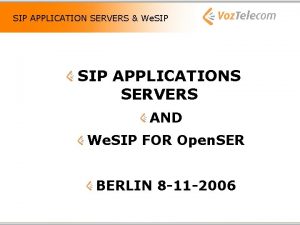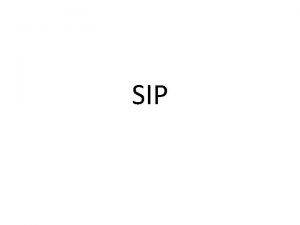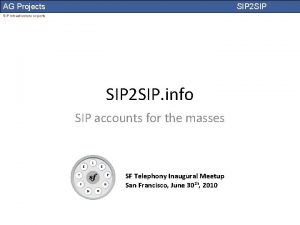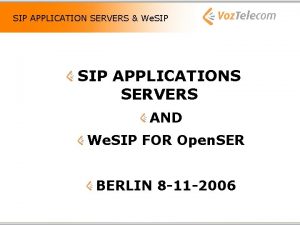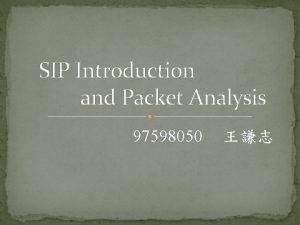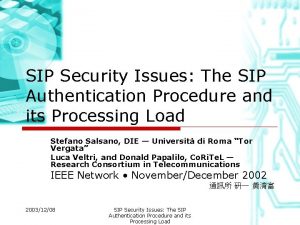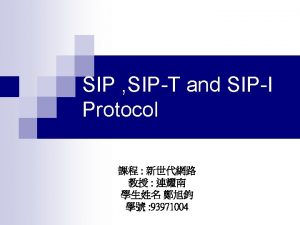SIP and the application of SIP as used

















- Slides: 17

SIP and the application of SIP as used in 3 GPP Keith Drage - Lucent Technologies

Overview of the 3 GPP IM CN subsystem architecture • Independent of the access mechanism • Mobility provided by underlying access mechanism • Functional entities use IPv 6 • Functionality apportioned between visited network and home network • Home network control of services

Overall 3 GPP architecture GPRS IM CN subsystem

GPRS - user plane versus transport plane User IPv 6 GGSN Terminal UTRAN Application Server Core Network Transport IPv 6 – User and transport planes are completely independent, i. e. the transport plane can run on a different IP version than the user plane – UTRAN and Core Network transport can also run on different IP versions

GPRS - Transport of user IP packets in UMTS User IPv 6 (PDP type IPv 6) UTRAN Terminal Radio Bearer SGSN GTP-U GGSN Application Server GTP-U IP packets to/from the terminal are tunneled through the UMTS network, they are not routed directly at the IP level.

3 GPP requires multiple outbound proxies REG UA 200 OK REG PCSCF 200 OK REG ICSCF 200 OK SCSCF User Visited Home equipment network P-CSCF - Proxy CSCF (Call Session Control Function). The terminals point of contact in the visited network after registration. Point where network places constraint on the bearer. I-CSCF - Interrogating-CSCF. Responsible for finding the S-CSCF at registration. May also perform hiding of the S-CSCF network architecture. S-CSCF - Serving-CSCF. Responsible for identifying user’s service privileges. Responsible for selecting access to home network application server (service platform) and for providing access to that server.

Example allocation of functional entities - mobile to mobile User A A’s visited network GPRS P-CSCF Required on A’s home network registration, optional on sessiion establish S-CSCF I-CSCF Optional User B I-CSCF S-CSCF B’s home network Required on registration, optional on sessiion establish GPRS P-CSCF B’s visited network

Example allocation of functional entities - PSTN to mobile MGW User B MGCF I-CSCF S-CSCF B’s home network Required on registration, optional on sessiion establish GPRS P-CSCF B’s visited network

Example allocation of functional entities - mobile to PSTN User A Required on A’s home network registration, optional on sessiion establish S-CSCF I-CSCF A’s visited network GPRS P-CSCF BGCF MGW SGW MGCF Breakout network

Provision of services SIP Application Server Sh ISC Sh Cx HSS S-CSCF ISC OSA Service Capability Server (SCS) OSA API ISC MAP IM SSF ISC interface runs the SIP protocol CAP CAMEL Service Environment OSA Application Server

Summary of architecture SLF HSS Dx Gm UA Mw P-CSCF AS Cx Cx Mw I-CSCF S-CSCF Mg Mg Mg BCGF MGCF Mc MGW

Key 3 GPP documents and their location on 3 GPP servers • TS 23. 228: "3 rd GPP; Technical Specification Group Services and System Aspects; IP Multimedia (IM) Subsystem - Stage 2". • TS 24. 228: "3 rd GPP; Technical Specification Group Core Network; Signalling flows for the IP multimedia call control based on SIP and SDP". • TS 24. 229: "3 rd GPP; Technical Specification Group Core Network; IP Multimedia Call Control Protocol based on SIP and SDP". • TS 23. 218: "3 rd GPP; Technical Specification Group Core Network; IP Multimedia (IM) Session Handling; IP Multimedia (IM) call model” These drafts can be found at the 3 gpp web site either at: • ftp: //ftp. 3 gpp. org/Specs/Latest_drafts/ • ftp: //ftp. 3 gpp. org/Specs/2001 -06/Rel-5 depending on the status of the document

Issues for SIP

Multiple outbound proxies path Insert P-CSCF address REG UA 200 OK Add I-CSCF address REG PCSCF Store S-CSCF and I-CSCF addresses 200 OK Store P-CSCF and I-CSCF addresses REG ICSCF 200 OK SCSCF Add S-CSCF address

Compression • Efficient use of bandwidth is required on the radio interface. • Will be applied to both the media streams (header compression or removal) and to the signalling bearers. • Compression / decompression of SIP will be performed by the UE and the P-CSCF. • These entities will also perform integrity protection on the signalling bearer.

Other issues still in discussion at requirements level • Emergency calls, and support of location based services, requires the transfer of location information (needs GEOPRIV to complete). • Interworking with external SIP environments requires transcoding support. Default codec for 3 GPP is the AMR codec. • There are functional entities which have not been shown in these slides which will require SIP support, e. g. MRF.

Questions
 We sip
We sip Hát kết hợp bộ gõ cơ thể
Hát kết hợp bộ gõ cơ thể Frameset trong html5
Frameset trong html5 Bổ thể
Bổ thể Tỉ lệ cơ thể trẻ em
Tỉ lệ cơ thể trẻ em Gấu đi như thế nào
Gấu đi như thế nào Chụp phim tư thế worms-breton
Chụp phim tư thế worms-breton Alleluia hat len nguoi oi
Alleluia hat len nguoi oi Các môn thể thao bắt đầu bằng từ đua
Các môn thể thao bắt đầu bằng từ đua Thế nào là hệ số cao nhất
Thế nào là hệ số cao nhất Các châu lục và đại dương trên thế giới
Các châu lục và đại dương trên thế giới Công thức tính độ biến thiên đông lượng
Công thức tính độ biến thiên đông lượng Trời xanh đây là của chúng ta thể thơ
Trời xanh đây là của chúng ta thể thơ Mật thư tọa độ 5x5
Mật thư tọa độ 5x5 Làm thế nào để 102-1=99
Làm thế nào để 102-1=99 Phản ứng thế ankan
Phản ứng thế ankan Các châu lục và đại dương trên thế giới
Các châu lục và đại dương trên thế giới Thơ thất ngôn tứ tuyệt đường luật
Thơ thất ngôn tứ tuyệt đường luật
